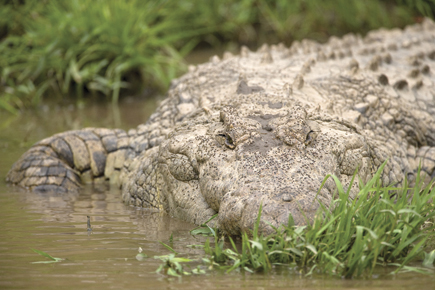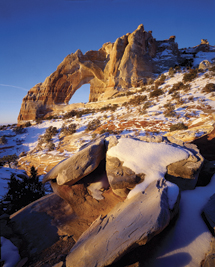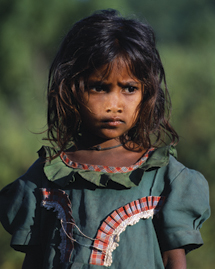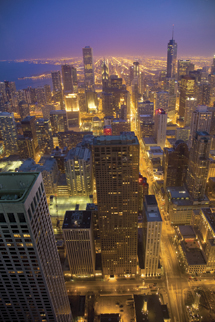Depth Of Field
Depth Of Field
Creative Focus Effects
by Jim Zuckerman
One of the most important concepts in photography, and one that you have to deal with every time you take a picture, is depth of field. Depth of field refers to how much of the scene is in focus in front of and behind the subject on which you’ve focused. For example, the picture of the Nile crocodile (#1) has shallow depth of field. Notice the grass in the foreground is soft, the head of the crocodile is sharp, and the back of the reptile and the distant background are significantly out of focus. In some instances, depth of field can be so shallow that mere inches, or even millimeters, make a difference. Photo (#2) shows a katydid whose face is sharp, but the flower in front of it that’s about 1” closer to the lens is soft.
 |
|
|
 |
|
|
At the opposite end of the spectrum is White Mesa Arch in Arizona (#3). This shows extensive depth of field where the immediate foreground as well as the distant arch in the background is tack sharp.
 |
|
|
Depth of field is a big deal in photography because it directly affects the artistry of your pictures. Sometimes you want it to be so shallow that the background is completely blurred with no definition at all. You can see in (#4) that the soft, green background gives us nothing to focus on except the red bellied woodpecker. This is a great way to direct a viewer’s attention exactly where you want it—on the subject. You can do the same thing when photographing people as you can see in the portrait of a little girl in India (#5).
 |
|
|
 |
|
|
Out of focus backgrounds are not only acceptable; many times they are desirable. However, out of focus foregrounds are usually unattractive and very distracting. For example, (#6) shows the leopard sharp but the large branch that was about 8 ft in front of the cat is soft. This degrades the artistry of the image significantly. Compare this with (#7) where I corrected this problem using Photoshop (more about this later). With the foreground branch sharp, the picture is now flawless. Notice that the background is out of focus, but that’s fine. It means that nothing behind the cat competes for attention.
Another example of where an out of focus foreground isn’t ideal is the close-up of a tegu (#8). Notice that the tip of the nose is soft. I feel that this kind of detail in close proximity to the camera should be sharp.
 |
|
|
 |
|
|
 |
|
|
Can foregrounds ever be out of focus and work? Yes, they can. However, they should be significantly out of focus so they end up being a blur of color. For example, in the portrait I took in Papua New Guinea (#9), the fern closest to the camera blurred completely. I did this to imply that the Huli warrior is an integral part of the jungle. Similarly, in (#10), the out of focus foreground grass shows the lion camouflaged in its natural environment. The focus is on the young cat, but the soft foreground creates the feeling that we are getting an intimate look into the private life of this wild animal.
 |
|
|
 |
|
|
Manipulating Depth Of Field
There are three ways to manipulate depth of field in your pictures. These three factors come into play every time you take a shot.
1. Focal length of the lens. The longer the focal length, the less depth of field you have. Conversely, as the focal length gets shorter, depth of field increases. Long telephotos, then, have very shallow depth of field. You can see this very clearly in photo (#6), in which the branch in the foreground is soft, and in (#4) the background foliage behind the woodpecker is completely out of focus because I used a 500mm plus a 1.4x teleconverter, making the lens 700mm (more about teleconverters later).
2. Lens aperture. As you close the lens down to a small opening, like f/16, f/22, or f/32, depth of field increases to the maximum the lens can provide. When you choose to use large lens apertures like f/2.8 and f/4, you lose depth
of field.
3. Distance to the subject. When you move in close to a subject, such as when doing macro (close-up) photography or when you want to fill the frame with a small object, depth of field decreases. Conversely, as you back away and put a greater distance between the camera and the subject, depth of field increases.
There is a fourth factor that influences depth of field, but it is relevant only when doing close-up photography. By placing the camera such that the back of it (i.e. the plane of the digital sensor) is parallel with the subject, you will increase depth of field. When the camera is positioned such that the back of it is oblique to the plane of the subject, you lose depth of field.
Let’s look at some examples of different subjects and I’ll explain how these factors interact with each other.
When Depth Of Field Doesn’t Matter
There are two photographic situations in which depth of field does not have to be considered at all. In other words, everything will be in focus at any lens aperture. The first case happens when the elements in the scene are far away. Photo (#11) of Chicago was taken from the 94th floor of the John Hancock building, and the skyscrapers were all quite a distance away. Any lens aperture used would produce the same depth of field you see here. The same is true for the village I photographed in fog along the Cinque Terre coast in Italy (#12). This was taken at f/5.6 because a smaller lens aperture wasn’t necessary to get the entire image sharp.
 |
|
|
 |
|
|
The second example has to do with photographing something that has a single plane. Photo (#13) is the side of a bed and breakfast establishment in Austria, and even though this wall and the flowers in front of it obviously have depth, from my shooting position of about 30 ft away there appeared to be a single vertical plane. Whether I used f/2.8 or f/16, the depth of field in this shot would be the same.
 |
|
|
Integrating Principles
The three ways you manipulate the focus in your images work together and, in fact, influence each other. This may be a strange way to describe what happens, but it’s nevertheless true.
For example, large lens apertures give you shallow depth of field. However, if you are also using a wide angle lens—which has tremendous depth of field—much more of the picture comes into focus than you might expect. The photo of the interior of St. Mark’s cathedral in Venice, Italy (#14), was taken at f/3.5 due to the dim ambient light and the fact that I couldn’t use a tripod. As you can see, the foreground is sharp and so is the distant background. This only happened because the depth of field capability of the ultra wide 14mm lens eclipsed the large aperture’s influence. Had I used a normal or telephoto lens from this same shooting position (and gotten a very different composition, of course), I would not have been able to get the entire shot tack sharp from the foreground to the background.
 |
|
|
Let’s add another factor into the mix. If I had placed the 14mm lens only 3” away from the foreground mosaics and the lens aperture was still f/3.5, the depth of field would have been significantly decreased. Specifically, if I focused close to the camera position, the background would have been soft. In that case, the way I could have recovered the loss of depth of field—assuming I didn’t want to change the camera position of being 3” away from the foreground—would be to use a smaller lens aperture like f/16 or smaller. That, however, would have required a tripod because in the dim light of the cathedral, the shutter speed would have to be too long for hand-holding.
As you can see, in this example the ultra wide angle influenced the amount of depth of field the f/3.5 aperture was able to produce, and the close proximity to the foreground would override the incredible depth of field of the lens.
Let’s take another example. Photo (#15) was taken in Papua, New Guinea with a 19mm focal length (I used a 16-35mm wide angle zoom) on a full frame sensor camera. The background is out of focus but it is still defined. If I wanted to completely blur the vegetation behind my subject, what were my options? I could use a larger aperture, true, but this was taken with f/7.1. Opening the lens up 2-3 f/stops while using a wide angle lens wouldn’t blur the jungle enough. Had I used a telephoto, the larger aperture would, in fact, significantly influence the focus on the background. Since wide angles inherently have so much depth of field, a larger aperture would only make a small change.
 |
|
|
I could move even closer to the subject, but a few more inches wouldn’t matter much. My only option, then, was to change lenses and use a telephoto. In addition, if I asked the subject to move away from the background about 15 or 20 ft, that would make a huge difference as well. So, to effectively blur the background I would need to do three things:
1. Use a telephoto lens, and the longer the lens the more out of focus the background would be.
2. Use a large lens aperture.
3. Ask the subject to move further away from the background.
I have simulated the effect of an out of focus background using Photoshop in photo (#16) because I didn’t do this at the time. You can see, though, how the three factors that allow you to manipulate depth of field don’t work in a vacuum. They work in conjunction with each other in every picture you take.
 |
|
|
The Tripod Factor
Tripods are an important part of the equation in enabling you to manipulate depth of field for this reason: When you close the lens down to use a small aperture, less light enters the camera. This means that the meter must compensate for that light loss to maintain a correct exposure, and the shutter speed therefore becomes longer. A tripod makes the camera immovable, thus eliminating the possibility of getting blurred pictures of stationary objects.
When you move in very close to small objects, i.e. when you are doing macro photography, depth of field becomes extremely limited simply because the shooting distance between subject and lens is so close. Consequently small apertures are often used in macro work to recover that loss in depth of field, and therefore we are forced to use slow shutter speeds. If you don’t use a tripod when doing macro photography, you are shooting yourself in the foot. It will be a self-defeating endeavor because you will get pictures that are either blurred or that have very shallow depth of field. The same is true when using long telephoto lenses. Movement is greatly magnified in these lenses, and a tripod stabilizes the camera and lens and helps you get sharp pictures.
- Log in or register to post comments












































